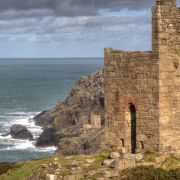Wheal Trewavas Mine
Perched precariously on the cliffs to the east of Trewavas Head are the two engine houses that form the remains of Wheal Trewavas mine. The mine worked four copper lodes which ran in a south easterly direction under the sea bed. These were the North Lode; Sowan Way Lode; Trewavas South (Old) Lode and Nimble Cutter Lode. There was also a tin lode which ran across the other lodes in an east to west direction. Three shafts were sunk:
Old Engine; New Engine or Roger's was named after the 1838 pumping house with its 45 inch engine a couple of hundred yards to the east. The final shaft was Diagonal Shaft reaching 600 feet down and out under the sea. This incorporated a 70 inch pumping engine which replaced that of New Engine Shaft.
The western engine house features a large circular stone platform which is a good example of a capstan round or manual capstan plat which is apparently sometimes used by Culdrose helicopter pilots for landing practice.
The operation ran between 1834 and 1846 and was a moderately succesful mine employing around 160 men and bringing up around 17,500 tons of copper ore valued at over £100,000 in those days. The mine was eventually flooded and abandoned. It is likely this was allowed to happen due to the diminishing yield making it unviable to continue mining. In fact it has been suggested that at the end of Wheal Trewavas' years the dividend was being paid out of bank overdrafts.
Because of the way the engine houses cling to the cliff side the walls on the seaward side of the engine houses are significantly taller to compensate for the slope.
The present day site is well worth a visit although a degree of caution is advised owing to the precarious position and the fact the engine houses are in a fairly bad state of repair.






